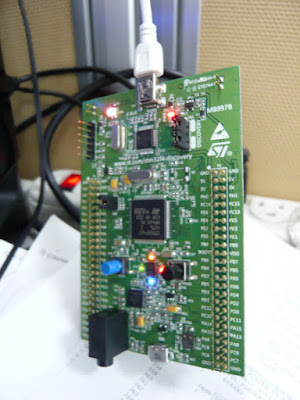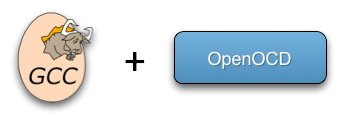作業系統之前的程式 for stm32f4discovery (0) - 打造 linux 開發環境
来源:互联网 发布:歌曲软件下载大全 编辑:程序博客网 时间:2024/05/22 23:50
the 1st edition: 20130405
the 2nd edition: 20150119
這個系列累積了不少篇幅, 以下是所有系列的文章目錄:
bare-metal for stm32f4 discovery board content
在《作業系統之前的程式》這系列 x86 os kernel 開發紀錄的學習經驗, 我想依樣畫葫蘆拿到 arm 的學習上, 重新學習一個完全不一樣的平台。
 Fig 1. stm32f4discovery這是一個辛苦的開始, 縱使有了 x86 的學習經驗, 也無法帶來太多的助益, 仍然需要閱讀大量的資料, 甚至去找到相關資料也是個難題, 而程式的撰寫也只是最基本的練習。
Fig 1. stm32f4discovery這是一個辛苦的開始, 縱使有了 x86 的學習經驗, 也無法帶來太多的助益, 仍然需要閱讀大量的資料, 甚至去找到相關資料也是個難題, 而程式的撰寫也只是最基本的練習。
但在開始第一個作業系統之前的程式 for stm32f4discovery 之前, 得先來打造開發環境, 這是與 x86 native toolchain 不同的地方, 別小看這部份, 這可不是一件容易的事, 最主要的部份就是 arm toolchain (cross compiler) 和燒錄程式碼到 stm32f4discovery flash 的工具。
目前市面上琳琅滿目的開發板, 要從中挑選實在不容易。Fig 1 是 stm32f4discovery, jserv 的進階嵌入式系統開發與實作課程 (201209~201301) 就是使用這塊開發板, 以 700 NT 購得。因為參加了這個課程, 所以才選定這塊開發板, 照著課程的資源來學習, 最是省事。
選擇板子時會有一個問題, 怎麼把程式碼燒錄到那塊板子上呢? 這是個大問題。而這塊開發板珍貴的地方就是內建 ST-LINK/V2, 可以將程式碼燒錄到 flash, 再也不怕燒爛 flash; 更珍貴的地方是: 還可以使用類似 jtag 的方式 debug, 不用另外買個 jtag, 當然這些都需要搭配的軟體才能運作, openocd 或是 st-util 都可以做到, 這是開發 os 等級程式碼的利器。我知道還有一塊版子也有類似的功能, freescale m0+ 系列, 使用的是 opensda, 不過我不確定 openocd 是不是可以支援 opensda。
而 stm32 提供了 bootloader 的方式, 就算沒有 st-link 也可以燒錄程式, 但還要調整 jmp, 不是很方便。有興趣可參考: stm32f4discovery system memory - boot loader
Arduino 或是 Intel Galileo 這種開發版主打快速、簡單、好開發。看看這些書名就可窺探一二:
不過偶爾看到別人用這些東西做出很好玩的東西, 例如機器手臂、機器人, 自己卻和 datasheet, c/asm code, debugger 打交道, single step 錯誤的程式碼, 而終端機畫面只有一些簡易的文字訊息, 還真是有些落漠之感, 我也想做出一些有趣的裝置。
《maker 雜誌中文版》有更多類似這樣的作品, 每一件都很能吸引人。
回到 stm32, stm32f4 mcu 全系列可參考這裡。
這是以 ARM Cortex-M4 為核心的開發版。沒有 mmu, 所以不能練習 page mapping, 這是我覺得比較可惜的部份; 但有個記憶體保護單元 (MPU), 可以保護某個記憶體區塊。這塊板子用的是 stm32 的 STM32F407VG, 其基本規格:
時脈: 168 MHz
flash & ram size:
STM32F407VGT6 microcontroller featuring 1 MB of Flash memory, 192 KB of RAM in an LQFP100 package.
以下的連結可以下載 firmware, 方便寫程式, 不用辛苦的對付暫存器。
Related Tools and Software Part Number Description STM-STUDIOSTM Studio run-time variables monitoring and visualization tool for STM8 and STM32 microcontrollersSTM32CubeF4Embedded software for STM32 F4 series (HAL low level drivers, USB, TCP/IP, File system, RTOS, Graphic - coming with examples running on ST boards)STSW-STM32068STM32F4DISCOVERY board firmware package, including 22 examples (covering USB Host, audio, MEMS accelerometer and microphone) (AN3983)STSW-STM32142Using STM32F4 MCU power modes with best dynamic efficiency (AN4365)
我還真不習慣只有 192KB 的記憶體。
usb 有兩邊, 插上 CN1 (如 Fig 1 白色 usb 線) 接到 pc 後, 就可看到 led 燈的閃爍效果 (如 Fig 1), 代表這是一塊正常的板子。開發程式, 燒錄程式也都是接在 CN1 上, 這是 ST-LINK/V2 chip 提供的功能。
 這塊板子相關的 datasheet 和 sample code: datasheet for stm32f4 discovery
這塊板子相關的 datasheet 和 sample code: datasheet for stm32f4 discovery
這 3 本的厚度不輸給 intel 那 3 本, 真的很厚, 有得看了。
stm32f4 - discovery 用的是 stm32f407, 詳細的 mcu 資訊要找這顆的 datasheet。
stm32f407 datasheet: http://www.st.com/st-web-ui/static/active/en/resource/technical/document/reference_manual/DM00031020.pdf
以下連結已經失效:
http://www.st.com/internet/com/TECHNICAL_RESOURCES/TECHNICAL_LITERATURE/REFERENCE_MANUAL/DM00031020.pdf
除了開發環境之外, 文件的閱讀也是一個難題, 並不是只讀 stm32f407 datasheet 就足夠。
AN2606 Application note 提到 system memory 的 bootloader。
UM0462 在介紹 flash loader demonstrator 的用法。
AN3155 Application note 介紹 USART protocol used in the STM32 bootloader。
用原廠準備的環境 (on ms windows), STM 沒提供自己的開發工具, 請參考: What should I use to develop on STM32? stm 有支援這些開發工具, 一定可以減輕開發環境的先前準備工作, 而 free 的版本幾乎都會有些限制, 例如執行檔大小不能超過 32K, 其實好像也不太容易超過這限制。而我習慣 linux vi + makefile 的工作環境, 打造這樣的開發環境並不算輕鬆, 否則也不會特地 blog 一篇, 來照著課程自虐吧!
在 linux 上的開發方式:

toolchain & qemu stm32 模擬器: http://wiki.csie.ncku.edu.tw/embedded/Lab1
如果你喜歡從原始碼建立編譯器工具組的話可以參考以下連結, toolchain build from source:
我自己準備了 4.7, 4.8, 4.9.2 (從上述第四個修改而來) 三個版本。
arm-2013.05-23-arm-none-eabi.src.tar.bz2 (上述第一個 url) 這個版本, 需要使用 makeinfo 4.13 (texinfo-4.13.tar.gz) 才可以正確編譯 binutils doc 目錄, 在我的 debian makeinfo 是 5.2 會在編譯 binutils 出問題。目前的版本已經修正這問題。
使用 openocd/stlink 來將程式寫到 stm32f4discovery flash (openocd/stlink/serialusb) :
http://wiki.csie.ncku.edu.tw/embedded/Lab6
Bus 002 Device 003: ID 0483:3748 SGS Thomson Microelectronics ST-LINK/V2
stlink gui
ref: http://openocd.sourceforge.net/
new git url:
git://git.code.sf.net/p/openocd/code
openocd 不是很好上手的工具, 設定也不容易。
openocd 需要設定檔, 長這樣:
這是給 STM32F4Discovery 用的, 若是使用其他 jtag 設備或是其他開發版, 設定會不同, 這個不好設定, 需要 jtag 相關知識。
openocd/share/openocd/scripts/* 有很多類似的設定檔。
執行 openocd:
若你也把 Programming STM32 F2, F4 ARMs under Linux: A Tutorial from Scratch 裡頭的程式跑過一次, 就可體會整個開發流程了。上表就是這連結的內容。
這個 gdb script 可以減輕打字份量。
arm-none-eabi-gdb -x g1.sh
https://github.com/texane/stlink 的 readme 有些有用的資訊, 可瀏覽一下。
有個 free ide 可以參考:
http://www.coocox.org/index.html
原來 arm 除了 armcc 還有 arm gcc。
ref: https://launchpad.net/gcc-arm-embedded/+download
function reference:
http://stm32.kosyak.info/doc/struct_g_p_i_o___init_type_def.html
有了模擬器就不一定要把程式寫到版子上的 flash, flash 壽命有限, 減少讀寫次數不是壞主意。不過模擬器模擬的是 stm32-p103, 我使用的是 stm32f4 discovery, IO 部份可能有些不同, 僅能用來練習 arm coretex m 系列不含 IO 的程式, 而 qemu 似乎沒有模擬 svc, 我在測試有關 svc 的部份時, 都是使用真實開發板。若真要寫 stm32f4 開發版的程式, 最後還是得寫入 flash/ram 來測試, 只能在模擬器執行的程式, 那有什麼意思呢!
中文教學文件: http://wiki.csie.ncku.edu.tw/embedded/2012w7
恭喜! 看完這些文件和打造工作環境就去了半條命了吧!在 linux 下打造這些環境就要花上不少時間。不過真正的困難才剛開始, 先來練習模擬器上的程式, 不需要 st-link, openocd。
簡單的版本很簡單, 難的版本很難, 跟著 http://wiki.csie.ncku.edu.tw/embedded/Lab1 把 main.c compile 起來吧!
文件中的模擬器在這裡 https://github.com/beckus/qemu_stm32, 可自行更新。
這個簡單的程式隱藏了很多很多的細節, 會讓我們誤以為寫個 mcu 程式很簡單, 塞個 main 在裡頭就可以了。使用廠商給的 library 來開發有點像在 os 下寫應用程式, 也不是壞事, 只不過這標題是作業系統之前的程式, 自然不用這樣的開發方式, 得把隱藏在 library 下的秘密挖出來, 不過光是打造開發環境就很辛苦了, 先讓自己輕鬆一下。
這支程式不能在 stm32f4 - discovery 正確執行, 別浪費時間寫到 flash 中, 在模擬器練習即可, 這是暖身用的。
用這樣的方式來啟動 qemu stm32 模擬器
開啟另外一個終端機:
這樣就像是在 x86-pc/linux 下使用 gdb。
lm3s6965evb 是 ti 的版子, 官方 qemu 即內建, 不用另外找 patch, 在我測試 cm3 和週邊無關的程式碼時, 相當方便。
ref:
http://www.techtraining.eng.br/files/uploads/2013/04/18/lm3s6965-evm.pdf
openocd load file to memory:
這樣就可以不用寫到 flash, 直接 load 到 sram 測試。
ref: http://openocd.sourceforge.net/doc/html/General-Commands.html
openocd 似乎有些問題, 若遇到奇怪的問題可使用 st-util 配合 gdb 來 debug, 也有可能需要重新開機。
arm-none-eabi-gdb
target remote localhost:4242
也可以指定 gdb port
root@w-linux:descent# st-util -p 1234
arm-none-eabi-gdb
target remote localhost:1234
blackmagic (類似 openocd, st-util 的 tool):
https://github.com/blacksphere/blackmagic/wiki
http://embdev.net/articles/STM_Discovery_as_Black_Magic_Probe
STM32Cube (新版的 library): http://www.st.com/web/catalog/tools/FM147/CL1794/SC961/SS1743/LN1897
ref:
the 2nd edition: 20150119
這個系列累積了不少篇幅, 以下是所有系列的文章目錄:
bare-metal for stm32f4 discovery board content
在《作業系統之前的程式》這系列 x86 os kernel 開發紀錄的學習經驗, 我想依樣畫葫蘆拿到 arm 的學習上, 重新學習一個完全不一樣的平台。
但在開始第一個作業系統之前的程式 for stm32f4discovery 之前, 得先來打造開發環境, 這是與 x86 native toolchain 不同的地方, 別小看這部份, 這可不是一件容易的事, 最主要的部份就是 arm toolchain (cross compiler) 和燒錄程式碼到 stm32f4discovery flash 的工具。
目前市面上琳琅滿目的開發板, 要從中挑選實在不容易。Fig 1 是 stm32f4discovery, jserv 的進階嵌入式系統開發與實作課程 (201209~201301) 就是使用這塊開發板, 以 700 NT 購得。因為參加了這個課程, 所以才選定這塊開發板, 照著課程的資源來學習, 最是省事。
選擇板子時會有一個問題, 怎麼把程式碼燒錄到那塊板子上呢? 這是個大問題。而這塊開發板珍貴的地方就是內建 ST-LINK/V2, 可以將程式碼燒錄到 flash, 再也不怕燒爛 flash; 更珍貴的地方是: 還可以使用類似 jtag 的方式 debug, 不用另外買個 jtag, 當然這些都需要搭配的軟體才能運作, openocd 或是 st-util 都可以做到, 這是開發 os 等級程式碼的利器。我知道還有一塊版子也有類似的功能, freescale m0+ 系列, 使用的是 opensda, 不過我不確定 openocd 是不是可以支援 opensda。
而 stm32 提供了 bootloader 的方式, 就算沒有 st-link 也可以燒錄程式, 但還要調整 jmp, 不是很方便。有興趣可參考: stm32f4discovery system memory - boot loader
Arduino 或是 Intel Galileo 這種開發版主打快速、簡單、好開發。看看這些書名就可窺探一二:
- Arduino 快速上手指南
- Intel Galileo 快速上手指南
不過偶爾看到別人用這些東西做出很好玩的東西, 例如機器手臂、機器人, 自己卻和 datasheet, c/asm code, debugger 打交道, single step 錯誤的程式碼, 而終端機畫面只有一些簡易的文字訊息, 還真是有些落漠之感, 我也想做出一些有趣的裝置。
《maker 雜誌中文版》有更多類似這樣的作品, 每一件都很能吸引人。
回到 stm32, stm32f4 mcu 全系列可參考這裡。
這是以 ARM Cortex-M4 為核心的開發版。沒有 mmu, 所以不能練習 page mapping, 這是我覺得比較可惜的部份; 但有個記憶體保護單元 (MPU), 可以保護某個記憶體區塊。這塊板子用的是 stm32 的 STM32F407VG, 其基本規格:
時脈: 168 MHz
flash & ram size:
STM32F407VGT6 microcontroller featuring 1 MB of Flash memory, 192 KB of RAM in an LQFP100 package.
以下的連結可以下載 firmware, 方便寫程式, 不用辛苦的對付暫存器。
我還真不習慣只有 192KB 的記憶體。
usb 有兩邊, 插上 CN1 (如 Fig 1 白色 usb 線) 接到 pc 後, 就可看到 led 燈的閃爍效果 (如 Fig 1), 代表這是一塊正常的板子。開發程式, 燒錄程式也都是接在 CN1 上, 這是 ST-LINK/V2 chip 提供的功能。
這 3 本的厚度不輸給 intel 那 3 本, 真的很厚, 有得看了。
stm32f4 - discovery 用的是 stm32f407, 詳細的 mcu 資訊要找這顆的 datasheet。
stm32f407 datasheet: http://www.st.com/st-web-ui/static/active/en/resource/technical/document/reference_manual/DM00031020.pdf
以下連結已經失效:
除了開發環境之外, 文件的閱讀也是一個難題, 並不是只讀 stm32f407 datasheet 就足夠。
AN2606 Application note 提到 system memory 的 bootloader。
UM0462 在介紹 flash loader demonstrator 的用法。
AN3155 Application note 介紹 USART protocol used in the STM32 bootloader。
在 linux 上的開發方式:

toolchain & qemu stm32 模擬器: http://wiki.csie.ncku.edu.tw/embedded/Lab1
如果你喜歡從原始碼建立編譯器工具組的話可以參考以下連結, toolchain build from source:
- https://github.com/jsnyder/arm-eabi-toolchain (fb 顏 sir 提供)
- http://cu.rious.org/make/compiling-the-arm-cortex-m4-toolchain-yourself/
- https://github.com/cccc/STM32-Toolchain (gcc-4.8.0)
- STM32F4 – Build Your Own GNU ARM Cross-Toolchain From Scratch (cross compiler gcc 4.9 我使用 gcc 4.7 的版本才建構的出來)
(cross compiler gcc 5.1 我使用 gcc 4.9/5.2 的版本才建構的出來)
我自己準備了 4.7, 4.8, 4.9.2 (從上述第四個修改而來) 三個版本。
arm-2013.05-23-arm-none-eabi.src.tar.bz2 (上述第一個 url) 這個版本, 需要使用 makeinfo 4.13 (texinfo-4.13.tar.gz) 才可以正確編譯 binutils doc 目錄, 在我的 debian makeinfo 是 5.2 會在編譯 binutils 出問題。目前的版本已經修正這問題。
使用 openocd/stlink 來將程式寫到 stm32f4discovery flash (openocd/stlink/serialusb) :
http://wiki.csie.ncku.edu.tw/embedded/Lab6
Bus 002 Device 003: ID 0483:3748 SGS Thomson Microelectronics ST-LINK/V2
sudo apt-get install automake* libtool libusb-1.0-0-devapt-get install gdb-multiarchgit clone http://github.com/texane/stlink.gitcd stlink./autogen.sh./configure --prefix=/usrmakesudo make installsudo cp 49-stlinkv2.rules /etc/udev/rules.d/
stlink gui
git clone git://github.com/texane/stlink.gitsudo apt-get install libgtk-3-devcd stlink./configure --with-gtk && makecd gui && ./stlink-gui
apt-get install libjim-devcd openocd./bootstrap./configure --prefix=/opt/openocd \ --enable-jlink \ --enable-amtjtagaccel \ --enable-buspirate \ --enable-stlink \ --disable-libftdiecho -e "all:\ninstall:" > doc/Makefilemakesudo make install
ref: http://openocd.sourceforge.net/
new git url:
git://git.code.sf.net/p/openocd/code
openocd 不是很好上手的工具, 設定也不容易。
openocd 需要設定檔, 長這樣:
這是給 STM32F4Discovery 用的, 若是使用其他 jtag 設備或是其他開發版, 設定會不同, 這個不好設定, 需要 jtag 相關知識。
openocd/share/openocd/scripts/* 有很多類似的設定檔。
執行 openocd:
openocd -f openocd2.cfg
若你也把 Programming STM32 F2, F4 ARMs under Linux: A Tutorial from Scratch 裡頭的程式跑過一次, 就可體會整個開發流程了。上表就是這連結的內容。
這個 gdb script 可以減輕打字份量。
arm-none-eabi-gdb -x g1.sh
https://github.com/texane/stlink 的 readme 有些有用的資訊, 可瀏覽一下。
有個 free ide 可以參考:
http://www.coocox.org/index.html
原來 arm 除了 armcc 還有 arm gcc。
ref: https://launchpad.net/gcc-arm-embedded/+download
function reference:
http://stm32.kosyak.info/doc/struct_g_p_i_o___init_type_def.html
有了模擬器就不一定要把程式寫到版子上的 flash, flash 壽命有限, 減少讀寫次數不是壞主意。不過模擬器模擬的是 stm32-p103, 我使用的是 stm32f4 discovery, IO 部份可能有些不同, 僅能用來練習 arm coretex m 系列不含 IO 的程式, 而 qemu 似乎沒有模擬 svc, 我在測試有關 svc 的部份時, 都是使用真實開發板。若真要寫 stm32f4 開發版的程式, 最後還是得寫入 flash/ram 來測試, 只能在模擬器執行的程式, 那有什麼意思呢!
中文教學文件: http://wiki.csie.ncku.edu.tw/embedded/2012w7
恭喜! 看完這些文件和打造工作環境就去了半條命了吧!在 linux 下打造這些環境就要花上不少時間。不過真正的困難才剛開始, 先來練習模擬器上的程式, 不需要 st-link, openocd。
簡單的版本很簡單, 難的版本很難, 跟著 http://wiki.csie.ncku.edu.tw/embedded/Lab1 把 main.c compile 起來吧!
文件中的模擬器在這裡 https://github.com/beckus/qemu_stm32, 可自行更新。
這個簡單的程式隱藏了很多很多的細節, 會讓我們誤以為寫個 mcu 程式很簡單, 塞個 main 在裡頭就可以了。使用廠商給的 library 來開發有點像在 os 下寫應用程式, 也不是壞事, 只不過這標題是作業系統之前的程式, 自然不用這樣的開發方式, 得把隱藏在 library 下的秘密挖出來, 不過光是打造開發環境就很辛苦了, 先讓自己輕鬆一下。
這支程式不能在 stm32f4 - discovery 正確執行, 別浪費時間寫到 flash 中, 在模擬器練習即可, 這是暖身用的。
用這樣的方式來啟動 qemu stm32 模擬器
qemu_stm32/arm-softmmu/qemu-system-arm -M stm32-p103 -kernel mymain.bin -S -gdb tcp::1234qemu-system-arm -M lm3s6965evb -kernel list.bin -S -gdb tcp::1234
開啟另外一個終端機:
這樣就像是在 x86-pc/linux 下使用 gdb。
lm3s6965evb 是 ti 的版子, 官方 qemu 即內建, 不用另外找 patch, 在我測試 cm3 和週邊無關的程式碼時, 相當方便。
ref:
http://www.techtraining.eng.br/files/uploads/2013/04/18/lm3s6965-evm.pdf
openocd load file to memory:
> load_image /home/descent/git/jserv-course/stm32_prog/factorial.bin 0x2000000024 bytes written at address 0x20000000downloaded 24 bytes in 0.008389s (2.794 KiB/s)> mdb 0x20000000 240x20000000: 00 08 00 20 09 00 00 00 0a 20 00 21 09 18 01 38 7f f4 fc af ff f7 fe bf
這樣就可以不用寫到 flash, 直接 load 到 sram 測試。
ref: http://openocd.sourceforge.net/doc/html/General-Commands.html
openocd 似乎有些問題, 若遇到奇怪的問題可使用 st-util 配合 gdb 來 debug, 也有可能需要重新開機。
arm-none-eabi-gdb
target remote localhost:4242
也可以指定 gdb port
root@w-linux:descent# st-util -p 1234
arm-none-eabi-gdb
target remote localhost:1234
blackmagic (類似 openocd, st-util 的 tool):
https://github.com/blacksphere/blackmagic/wiki
http://embdev.net/articles/STM_Discovery_as_Black_Magic_Probe
STM32Cube (新版的 library): http://www.st.com/web/catalog/tools/FM147/CL1794/SC961/SS1743/LN1897
ref:
- http://wiki.csie.ncku.edu.tw/embedded/2012w7
- http://wiki.csie.ncku.edu.tw/embedded/Lab6
- HowTo_ToolChain_STM32_Ubuntu
- http://cms.mcuapps.com/techinfo/emulators/st-link/
- http://forum.ubuntu.org.cn/viewtopic.php?t=384021&p=2839453
- http://www.amobbs.com/forum-3020-1.html
- STM32 的 BOOT 概述
- Flashing programs to STM32. Embedded Bootloader
- Getting Started with the STM32F4 and GCC
- STM32 BOOT 位理解及设置
- Programming STM32 F2, F4 ARMs under Linux: A Tutorial from Scratch
- http://www.waveshare.net/shop/STM32F4DISCOVERY.htm
- STM32 笔记(七)IAR 平台,在内存中调试 STM32
- ARM9 2410 移植之在 Linux 下, 用 OpenJTAG+OpenOCD 燒寫 NAND Flash
- x86 版的 Arduino 來了,Intel Galileo 開發板的體驗、分析和應用
- book: Eclipse,OpenOCD,OpenJTAGv3.3 嵌入式开发教程
0 0
- 作業系統之前的程式 for stm32f4discovery (0) - 打造 linux 開發環境
- 作業系統之前的程式 for stm32f4discovery (0.5) - newlib
- 作業系統之前的程式 for stm32f4discovery (3) - usart
- 作業系統之前的程式 for stm32f4discovery (2) - 點亮 led, c version
- 作業系統之前的程式 for stm32f4 - discovery (0.2) - p103 模擬器
- 作業系統之前的程式 for stm32f4 - discovery (1) - 1 加到 10 , asm version
- Linux下程式的内存占用
- linux程式段错误的调试方法
- Linux 驅動程式的 I/O
- linux下的socket程式说明
- Linux设备驱动程式学习(0)
- 关于之前的for循环的写法
- 学习LINUX之前的准备
- 打造自己的chrome for android
- 打造自己的chrome for Android
- 打造专属的Chromium for Android
- 打造小的Linux系统
- 打造Linux下的LAMP
- android AsyncTask介绍
- Magento编译模式 - Magento Compiler Mode
- windows git 环境搭建
- Maximum Subarray Difference Solution
- java语言中的enum类型使用介绍
- 作業系統之前的程式 for stm32f4discovery (0) - 打造 linux 開發環境
- error: RPC failed; result=18, HTTP code = 200 gitlab 百兆以上库下载报错
- 写作的意境
- CocoaPads的安装(二)
- css3转盘抽奖示例-转指针
- PHP获取下个月的1月1日,唯一要解决的其实就是跨年的问题
- [3] Error writing file '/tmp/MYJtFFqc' (Errcode: 28)discuz错误解决方法
- 由浅入深学习自定义控件(5)-实现listview的下拉刷新及上拉加载
- 使用greenDao in Eclipse


